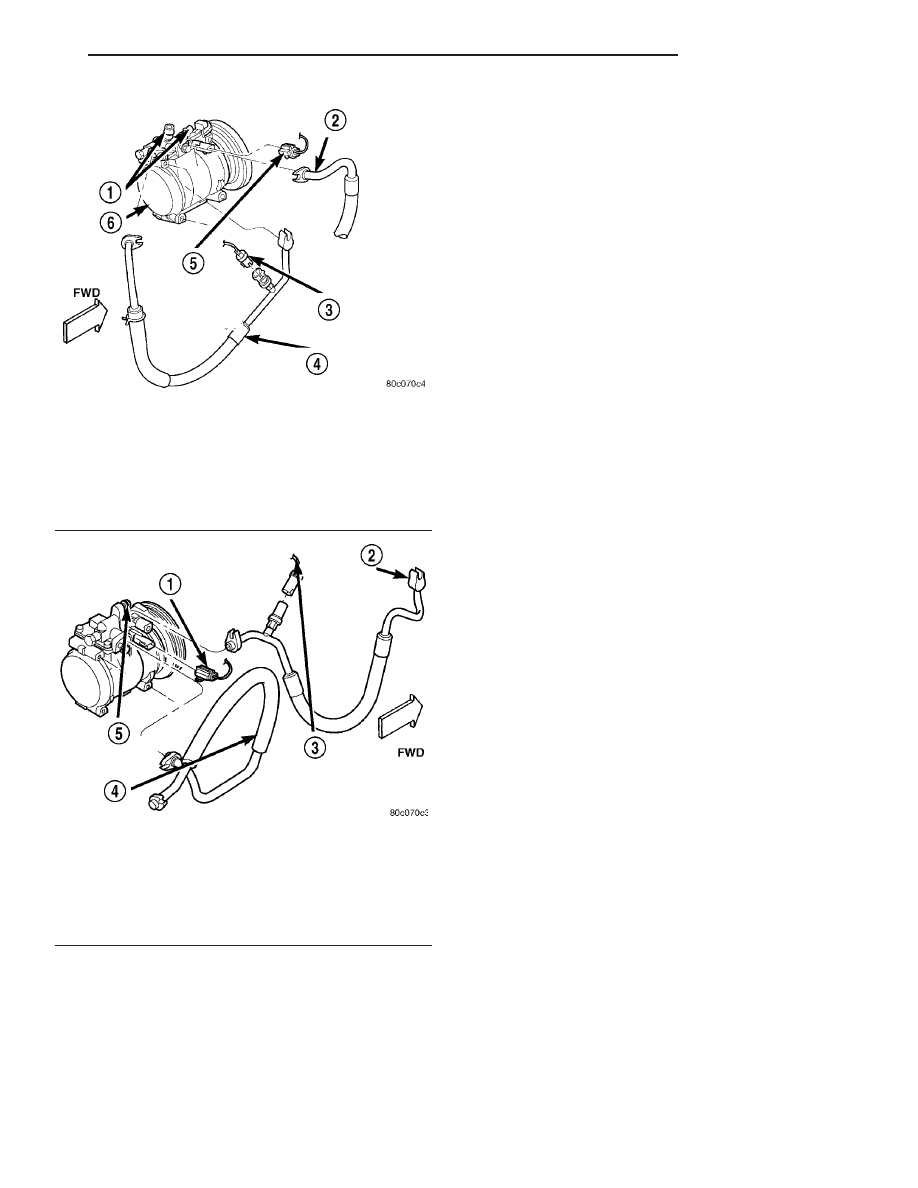Chrysler 300M, Dodge Interpid. Manual - part 401

Any kinks or sharp bends in the refrigerant plumb-
ing will reduce the capacity of the entire air condition-
ing system. Kinks and sharp bends reduce the flow of
refrigerant in the system. A good rule for the flexible
hose refrigerant lines is to keep the radius of all bends
at least ten times the diameter of the hose. In addi-
tion, the flexible hose refrigerant lines should be
routed so they are at least 80 millimeters (3 inches)
from the exhaust manifold (Whenever possible).
High pressures are produced in the refrigerant sys-
tem when the air conditioning compressor is operat-
ing. Extreme care must be exercised to make sure
that each of the refrigerant system connections is
pressure-tight and leak free. It is a good practice to
inspect all flexible hose refrigerant lines at least once
a year to make sure they are in good condition and
properly routed.
NOTE: Replace all O-rings and lubricate each with
ND-8 PAG oil before installation of component.
(1) Connect the discharge line at the A/C con-
denser. Tighten retainer bolt to 23 N·m (17 ft. lbs.).
(2) Connect the discharge line at the compressor.
Tighten retainer bolt to 23 N·m (17 ft. lbs.).
(3) Install the a/c pressure transducer. (Refer to 24
- HEATING & AIR CONDITIONING/CONTROLS/
A/C PRESSURE TRANSDUCER - INSTALLATION)
(4) Plug the harness connector into the a/c pres-
sure transducer.
(5) Connect the negative battery cable remote ter-
minal to the remote battery post.
(6) Evacuate the refrigerant system. (Refer to 24 -
HEATING & AIR CONDITIONING/PLUMBING -
STANDARD PROCEDURE -REFRIGERANT SYS-
TEM EVACUATE)
(7) Charge the refrigerant system. (Refer to 24 -
HEATING & AIR CONDITIONING/PLUMBING -
STANDARD PROCEDURE - REFRIGERANT SYS-
TEM CHARGE)
LIQUID LINE
REMOVAL
WARNING: REVIEW THE WARNINGS IN THE FRONT
OF THIS SECTION BEFORE PERFORMING THE
FOLLOWING OPERATION. (Refer to 24 - HEATING &
AIR CONDITIONING/PLUMBING - WARNING)
(1) Recover the refrigerant from the system. (Refer
to 24 - HEATING & AIR CONDITIONING/PLUMB-
ING - STANDARD PROCEDURE - REFRIGERANT
RECOVERY)
(2) Remove the engine air inlet tube and the air
distribution duct on vehicles equipped with 3.2/3.5 L
engines.
(3) Remove the a/c line to the expansion valve fas-
tener using a M10 Hex wrench. Remove the suction
line block from the expansion valve, cap the line and
swing it out of the way.
CAUTION: Cap off all lines that are not being
replaced. Cap/plug the expansion valve and con-
denser fittings.
Fig. 7 A/C PRESSURE TRANSDUCER AND
DISCHARGE LINE - 3.2L/3.5L
1 - SERVICE PORTS
2 - SUCTION LINE
3 - A/C PRESSURE TRANSDUCER AND CONNECTOR
4 - DISCHARGE LINE
5 - A/C COMPRESSOR CLUTCH ELECTRICAL CONNECTOR
6 - A/C COMPRESSOR
Fig. 8 A/C PRESSURE TRANSDUCER AND
DISCHARGE LINE - 2.7L
1 - A/C COMPRESSOR CLUTCH ELECTRICAL CONNECTOR
2 - DISCHARGE LINE
3 - A/C PRESSURE TRANSDUCER AND CONNECTOR
4 - SUCTION LINE
5 - A/C COMPRESSOR
LH
PLUMBING
24 - 35
A/C DISCHARGE LINE (Continued)